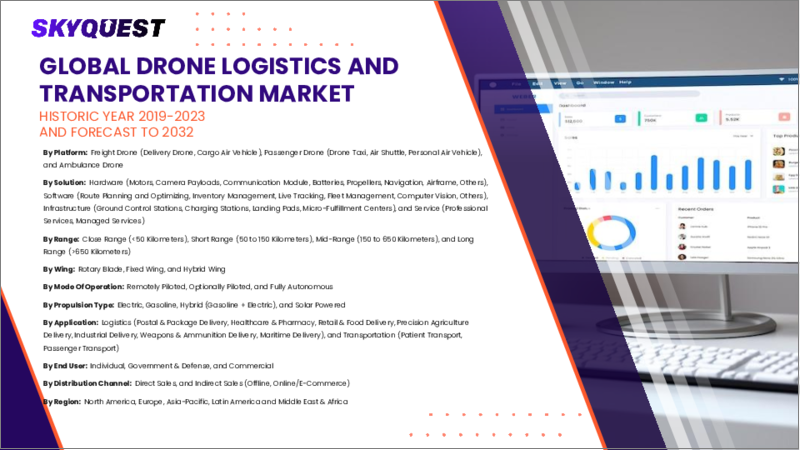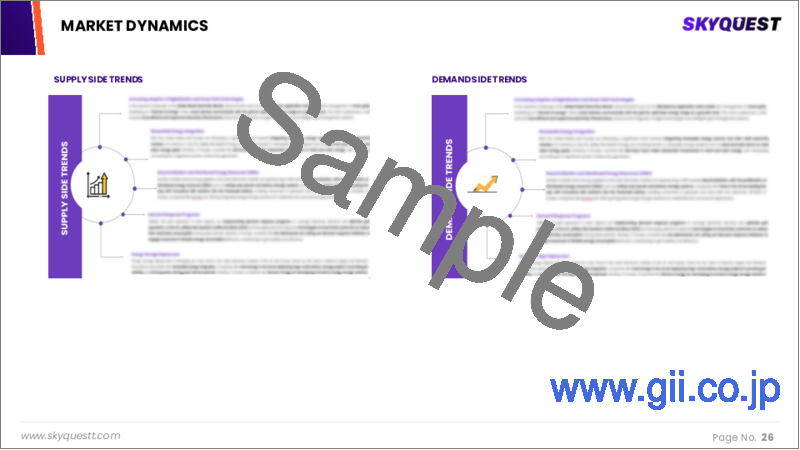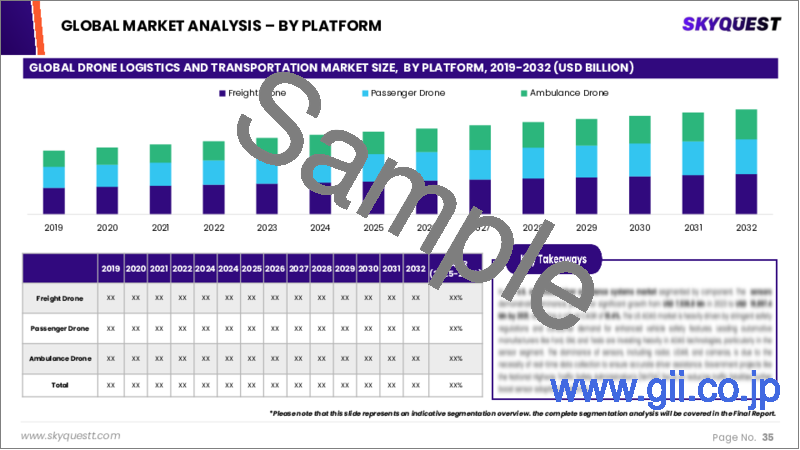|
|
市場調査レポート
商品コード
1673616
ドローン物流・輸送の市場規模、シェア、成長分析、プラットフォーム別、ソリューション別、航続距離別、用途別、エンドユーザー別、地域別 - 産業予測 2025~2032年Drone Logistics and Transportation Market Size, Share, and Growth Analysis, By Platform (Freight Drones, Passenger Drones), By Solution (Hardware, Software), By Range, By Application, By End User, By Region - Industry Forecast 2025-2032 |
||||||
|
|||||||
| ドローン物流・輸送の市場規模、シェア、成長分析、プラットフォーム別、ソリューション別、航続距離別、用途別、エンドユーザー別、地域別 - 産業予測 2025~2032年 |
|
出版日: 2025年03月02日
発行: SkyQuest
ページ情報: 英文 202 Pages
納期: 3~5営業日
|
全表示
- 概要
- 目次
ドローン物流・輸送の世界市場規模は、2023年に9億7,280万米ドルと評価され、2024年の14億5,142万米ドルから2032年には356億4,043万米ドルに成長し、予測期間中(2025年~2032年)のCAGRは49.2%で成長する見通しです。
eコマース配送におけるドローンの利用は、顧客の玄関先まで荷物を直接輸送するための、より迅速で効率的なソリューションを提供することで、ロジスティクスに変革をもたらしつつあります。このテクノロジーは、特に小口商品の配送時間とコストを大幅に削減する一方、多くの場合、多額の先行投資を必要とする従来の配送フリートに対するスケーラブルな代替手段を販売者に提供します。eコマースにとどまらず、世界中の企業がドローンを採掘、農業、物流などのサプライチェーンプロセスに組み込んでいます。テクノロジーの進化に伴い、ドローンは在庫管理やフォークリフトへの依存を最小限に抑えることで、倉庫業務も強化し、よりコスト効率の高いワークフローにつながっています。これらの動向を総合すると、世界のドローン物流・輸送市場は堅調な成長軌道を描いており、複数の業界における関連性の高まりを反映しています。
目次
イントロダクション
- 調査の目的
- 調査範囲
- 定義
調査手法
- 情報調達
- 二次と一次データの方法
- 市場規模予測
- 市場の前提条件と制限
エグゼクティブサマリー
- 世界市場の見通し
- 供給と需要の動向分析
- セグメント別機会分析
市場力学と見通し
- 市場概要
- 市場規模
- 市場力学
- 促進要因と機会
- 抑制要因と課題
- ポーターの分析
主な市場の考察
- 重要成功要因
- 競合の程度
- 主な投資機会
- 市場エコシステム
- 市場の魅力指数(2024年)
- PESTEL分析
- マクロ経済指標
- バリューチェーン分析
- 価格分析
- ケーススタディ
- 技術の進歩
ドローン物流・輸送の市場規模:プラットフォーム別& CAGR(2025-2032)
- 市場概要
- 貨物ドローン
- 乗客ドローン
- 救急ドローン
ドローン物流・輸送の市場規模:ソリューション別& CAGR(2025-2032)
- 市場概要
- ハードウェア
- ソフトウェア
- インフラストラクチャー
ドローン物流・輸送の市場規模:航続距離別& CAGR(2025-2032)
- 市場概要
- 短距離
- 中距離
- 長距離
ドローン物流・輸送の市場規模:用途別& CAGR(2025-2032)
- 市場概要
- 物流
- 交通機関
ドローン物流・輸送の市場規模:エンドユーザー別& CAGR(2025-2032)
- 市場概要
- 商業
- 軍事
- 政府
ドローン物流・輸送の市場規模:地域別& CAGR(2025-2032)
- 北米
- 米国
- カナダ
- 欧州
- ドイツ
- スペイン
- フランス
- 英国
- イタリア
- その他欧州地域
- アジア太平洋地域
- 中国
- インド
- 日本
- 韓国
- その他アジア太平洋地域
- ラテンアメリカ
- ブラジル
- その他ラテンアメリカ地域
- 中東・アフリカ
- GCC諸国
- 南アフリカ
- その他中東・アフリカ
競合情報
- 上位5社の比較
- 主要企業の市場ポジショニング(2024年)
- 主な市場企業が採用した戦略
- 最近の市場動向
- 企業の市場シェア分析(2024年)
- 主要企業の企業プロファイル
- 企業の詳細
- 製品ポートフォリオ分析
- 企業のセグメント別シェア分析
- 収益の前年比比較(2022-2024)
主要企業プロファイル
- Amazon(USA)
- DHL International GmbH(Germany)
- FedEx(USA)
- PINC Solutions(USA)
- CANA Advisors(USA)
- Drone Delivery Canada(Canada)
- Hardis Group(France)
- Skysense, Inc.(USA)
- Zipline(USA)
- DroneScan(South Africa)
- Infinium Robotics(Singapore)
- Workhorse Group(USA)
- SKYCART INC.(USA)
- Matternet(USA)
- Flirtey(USA)
- AIRMAP, INC.(USA)
- Altitude Angel(UK)
- EHANG(China)
- Flytrex(Israel)
- Uber Technologies Inc.(USA)
結論と提言
Global Drone Logistics and Transportation Market size was valued at USD 972.8 million in 2023 and is poised to grow from USD 1451.42 million in 2024 to USD 35640.43 million by 2032, growing at a CAGR of 49.2% during the forecast period (2025-2032).
The use of drones in e-commerce deliveries is transforming logistics by offering faster, more efficient solutions for package transport straight to customers' doorsteps. This technology significantly reduces delivery times and costs, especially for small items, while providing sellers with a scalable alternative to traditional delivery fleets, which often require substantial upfront investment. Beyond e-commerce, companies globally are integrating drones into supply chain processes, including applications in mining, agriculture, and logistics. As technology evolves, drones are also enhancing warehouse operations through inventory management and minimizing reliance on forklifts, leading to more cost-effective workflows. These trends collectively indicate a robust growth trajectory for the global drone logistics and transportation market, reflecting its increasing relevance across multiple industries.
Top-down and bottom-up approaches were used to estimate and validate the size of the Global Drone Logistics And Transportation market and to estimate the size of various other dependent submarkets. The research methodology used to estimate the market size includes the following details: The key players in the market were identified through secondary research, and their market shares in the respective regions were determined through primary and secondary research. This entire procedure includes the study of the annual and financial reports of the top market players and extensive interviews for key insights from industry leaders such as CEOs, VPs, directors, and marketing executives. All percentage shares split, and breakdowns were determined using secondary sources and verified through Primary sources. All possible parameters that affect the markets covered in this research study have been accounted for, viewed in extensive detail, verified through primary research, and analyzed to get the final quantitative and qualitative data.
Global Drone Logistics And Transportation Market Segments Analysis
Global Drone Logistics and Transportation Market is segmented by Platform, Solution, Range, Application, End User and region. Based on Platform, the market is segmented into Freight Drones, Passenger Drones and Ambulance Drones. Based on Solution, the market is segmented into Hardware, Software and Infrastructure. Based on Range, the market is segmented into Short Range, Medium Range and Long Range. Based on Application, the market is segmented into Logistics and Transportation. Based on End User, the market is segmented into Commercial, Military and Government. Based on region, the market is segmented into North America, Europe, Asia Pacific, Latin America and Middle East & Africa.
Driver of the Global Drone Logistics And Transportation Market
The Global Drone Logistics and Transportation market is significantly driven by an increasing consumer willingness to pay a premium for same-day delivery services. This trend is particularly pronounced in the booming e-commerce sector, where the demand for speedy, efficient, and affordable delivery solutions continues to rise. As the e-commerce landscape evolves, the need for reliable delivery methods has surged, prompting the widespread adoption of drones for various transportation needs. Drones are increasingly utilized globally to deliver essential goods, including postal items, healthcare products, pharmaceuticals, and medical supplies like medicines, blood, organs, and equipment, thereby enhancing logistics efficiency.
Restraints in the Global Drone Logistics And Transportation Market
The Global Drone Logistics and Transportation market faces several key restraints that impact its growth and efficiency. One significant challenge is the necessity for operators to guarantee the reliability of the entire drone system, encompassing the UAV, ground station, and communication infrastructure. Drones often operate at various altitudes and require adept personnel for remote control and management. As the demand for commercial drones rises, there is an increasing need for skilled pilots. Consequently, there is a concerted effort to enhance the autonomy of these systems, thereby minimizing human involvement and decreasing the likelihood of accidents stemming from insufficient operator skills.
Market Trends of the Global Drone Logistics And Transportation Market
The Global Drone Logistics and Transportation market is experiencing a robust trend driven by the rapid adoption of drone technology, particularly in last-mile logistics. As online retail continues to surge, businesses are increasingly leveraging drones to enhance delivery efficiency and reduce operational costs. This shift not only allows retailers to meet growing consumer demands for swift delivery but also positions them competitively in the market. Investments in innovative drone systems are escalating globally, enabling faster and more reliable delivery solutions. As a result, this sector is poised for significant growth, promising to transform logistics paradigms and redefine consumer expectations in the retail landscape.
Table of Contents
Introduction
- Objectives of the Study
- Scope of the Report
- Definitions
Research Methodology
- Information Procurement
- Secondary & Primary Data Methods
- Market Size Estimation
- Market Assumptions & Limitations
Executive Summary
- Global Market Outlook
- Supply & Demand Trend Analysis
- Segmental Opportunity Analysis
Market Dynamics & Outlook
- Market Overview
- Market Size
- Market Dynamics
- Drivers & Opportunities
- Restraints & Challenges
- Porters Analysis
- Competitive rivalry
- Threat of substitute
- Bargaining power of buyers
- Threat of new entrants
- Bargaining power of suppliers
Key Market Insights
- Key Success Factors
- Degree of Competition
- Top Investment Pockets
- Market Ecosystem
- Market Attractiveness Index, 2024
- PESTEL Analysis
- Macro-Economic Indicators
- Value Chain Analysis
- Pricing Analysis
- Case Studies
- Technology Advancement
Global Drone Logistics and Transportation Market Size by Platform & CAGR (2025-2032)
- Market Overview
- Freight Drones
- Passenger Drones
- Ambulance Drones
Global Drone Logistics and Transportation Market Size by Solution & CAGR (2025-2032)
- Market Overview
- Hardware
- Software
- Infrastructure
Global Drone Logistics and Transportation Market Size by Range & CAGR (2025-2032)
- Market Overview
- Short Range
- Medium Range
- Long Range
Global Drone Logistics and Transportation Market Size by Application & CAGR (2025-2032)
- Market Overview
- Logistics
- Transportation
Global Drone Logistics and Transportation Market Size by End User & CAGR (2025-2032)
- Market Overview
- Commercial
- Military
- Government
Global Drone Logistics and Transportation Market Size & CAGR (2025-2032)
- North America (Platform, Solution, Range, Application, End User)
- US
- Canada
- Europe (Platform, Solution, Range, Application, End User)
- Germany
- Spain
- France
- UK
- Italy
- Rest of Europe
- Asia Pacific (Platform, Solution, Range, Application, End User)
- China
- India
- Japan
- South Korea
- Rest of Asia-Pacific
- Latin America (Platform, Solution, Range, Application, End User)
- Brazil
- Rest of Latin America
- Middle East & Africa (Platform, Solution, Range, Application, End User)
- GCC Countries
- South Africa
- Rest of Middle East & Africa
Competitive Intelligence
- Top 5 Player Comparison
- Market Positioning of Key Players, 2024
- Strategies Adopted by Key Market Players
- Recent Developments in the Market
- Company Market Share Analysis, 2024
- Company Profiles of All Key Players
- Company Details
- Product Portfolio Analysis
- Company's Segmental Share Analysis
- Revenue Y-O-Y Comparison (2022-2024)
Key Company Profiles
- Amazon (USA)
- Company Overview
- Business Segment Overview
- Financial Updates
- Key Developments
- DHL International GmbH (Germany)
- Company Overview
- Business Segment Overview
- Financial Updates
- Key Developments
- FedEx (USA)
- Company Overview
- Business Segment Overview
- Financial Updates
- Key Developments
- PINC Solutions (USA)
- Company Overview
- Business Segment Overview
- Financial Updates
- Key Developments
- CANA Advisors (USA)
- Company Overview
- Business Segment Overview
- Financial Updates
- Key Developments
- Drone Delivery Canada (Canada)
- Company Overview
- Business Segment Overview
- Financial Updates
- Key Developments
- Hardis Group (France)
- Company Overview
- Business Segment Overview
- Financial Updates
- Key Developments
- Skysense, Inc. (USA)
- Company Overview
- Business Segment Overview
- Financial Updates
- Key Developments
- Zipline (USA)
- Company Overview
- Business Segment Overview
- Financial Updates
- Key Developments
- DroneScan (South Africa)
- Company Overview
- Business Segment Overview
- Financial Updates
- Key Developments
- Infinium Robotics (Singapore)
- Company Overview
- Business Segment Overview
- Financial Updates
- Key Developments
- Workhorse Group (USA)
- Company Overview
- Business Segment Overview
- Financial Updates
- Key Developments
- SKYCART INC. (USA)
- Company Overview
- Business Segment Overview
- Financial Updates
- Key Developments
- Matternet (USA)
- Company Overview
- Business Segment Overview
- Financial Updates
- Key Developments
- Flirtey (USA)
- Company Overview
- Business Segment Overview
- Financial Updates
- Key Developments
- AIRMAP, INC. (USA)
- Company Overview
- Business Segment Overview
- Financial Updates
- Key Developments
- Altitude Angel (UK)
- Company Overview
- Business Segment Overview
- Financial Updates
- Key Developments
- EHANG (China)
- Company Overview
- Business Segment Overview
- Financial Updates
- Key Developments
- Flytrex (Israel)
- Company Overview
- Business Segment Overview
- Financial Updates
- Key Developments
- Uber Technologies Inc. (USA)
- Company Overview
- Business Segment Overview
- Financial Updates
- Key Developments





